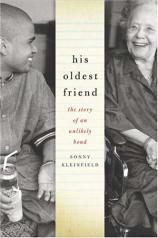His Oldest Friend: The Story of an Unlikely Bond
Review
His Oldest Friend: The Story of an Unlikely Bond
"When she met Elvis, she gave him a shy and friendly smile. He gave her a big smile back. But she wondered. What would a teenager want with her --- someone rolling around in a wheelchair, who relished opera, who didn't use a computer, who couldn't even get the infernal remote control to work?...Elvis was thinking something altogether different. He wondered, what would an old woman want with him --- a moody teenager from another part of the world, still trying to decipher girls, who relaxed with video games and rap music, who liked to toss down a few beers with the guys?"
This odd couple, introduced to us by award-winning reporter Sonny Kleinfeld, found in each other a kinship that is rare in the easiest of circumstances, and would appear an almost impossible bond in their situation.
Elvis Checo, a Dominican teen recently abandoned by his mother, needed a summer job. He heard about relatively easy work at the Jewish Home and Hospital for the Aged on the Upper West Side of Manhattan. The work was not onerous, and despite several tempestuous upheavals in his young life, Elvis stuck with it. Then one day he was approached by the daughter of one of the residents, Margaret Oliver, a nonagenarian who needed more companionship, more stimulation than the Home could supply.
Margaret had made a conscious decision, for she was still quite lucid, that she wanted to un-burden her daughter by moving into a nursing home where at least she would see people and remain active. The reality was not what she had imagined: "the dayroom was a chaos of women in wheelchairs, most of them inert, emaciated, cruelly smitten by the punishments of age…" There were rows of such denizens, who sat without speaking, or raged against unseen enemies, or traded gossip and shamelessly slandered their neighbors in an atmosphere too cold for the warm-hearted, gregarious Margaret.
Margaret learned to treat the staff respectfully and to ignore most of her fellow residents, gulping her meals quickly so as to avoid much contact with the mute and the mad (most residents over the age of 80 had dementia). Elvis, a bright, generous boy looking for a role model, found in Margaret a soul-mate. They helped each other. He came to solicit her advice, and to confide in her and she in him. His three hours a week stretched to garden wheelchair rambles and surprise visits. They traded jokes. He cheered her up when bad things happened, like when her new phone was stolen. She listened to his poetry and took it seriously. It was a relationship that transcended age, race, culture, and conventional notions of what friendship comprises.
HIS OLDEST FRIEND is inspirational without being even slightly sentimental. The prose is straightforward; the story, which could be maudlin if told by a less skilled craftsman, never lapses into pathos.
When the book ends, the story does not. Margaret and Elvis are still alive and kicking, philosophizing and kidding around. They go to a free concert at Lincoln Center and the arthritic old woman says she can't applaud because her hands don't make any noise.
"That's okay," Elvis said. "I'll applaud for both of us."
Reviewed by Barbara Bamberger Scott on January 22, 2011
His Oldest Friend: The Story of an Unlikely Bond
- Publication Date: September 7, 2005
- Genres: Biography, Nonfiction
- Hardcover: 288 pages
- Publisher: Times Books
- ISBN-10: 0805075801
- ISBN-13: 9780805075809



